Earthquake fault maps for Beverly Hills, Santa Monica and other Westside areas could bring development restrictions
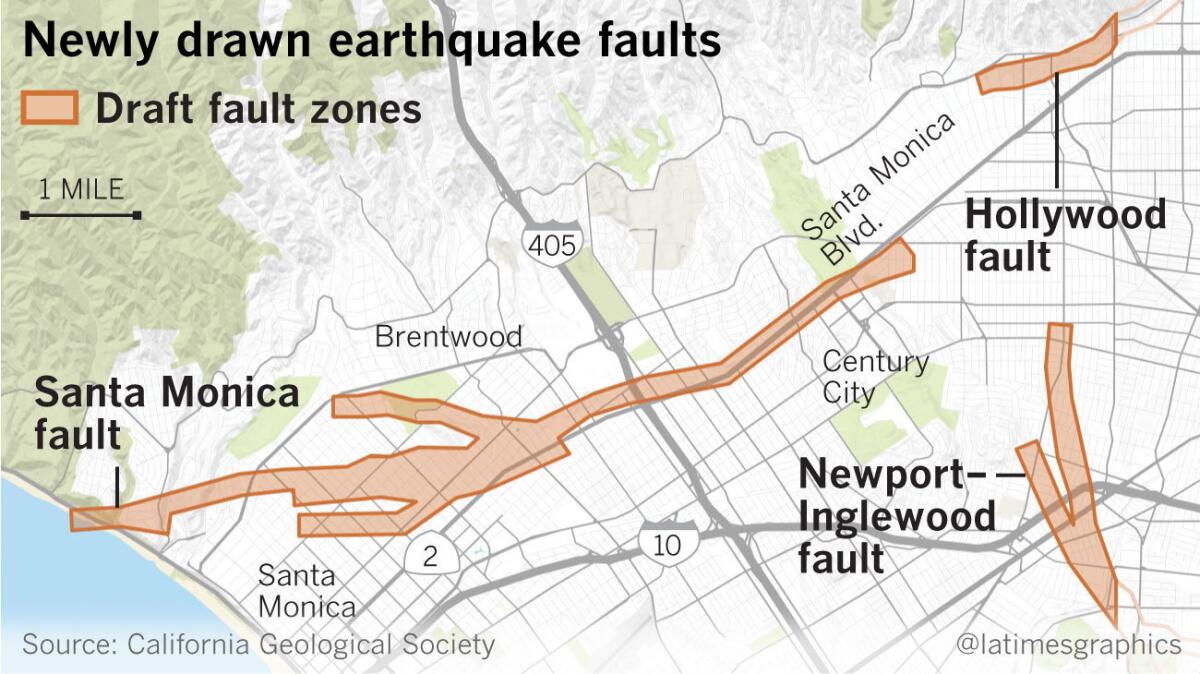
Officials on Thursday released new draft maps showing the locations of earthquake faults in Santa Monica, Beverly Hills and the Westside, raising the prospect of development restrictions in areas directly above the fissures.
The earthquake faults run along some of Southern California’s most expensive real estate, covering such tony neighborhoods as Brentwood and Pacific Palisades as well as Century City, Westwood and other premium business centers.
The long-awaited maps — which include new boundaries for the Santa Monica, Hollywood and Newport-Inglewood faults — are part of a new effort by the state to locate fault lines so that new buildings are not constructed on top of them.
Beverly Hills, Century City and Westwood

“It is important to not build on faults,” said Tim Dawson, senior engineering geologist for the California Geological Survey. “Building foundations will tend to break when the earth moves beneath them, damaging the building in the process.”
If the ground moves dramatically as a fault breaks the land, a building could completely collapse, Dawson said.
The release of the maps marks the first time the California Geological Survey has issued official draft maps for earthquake faults on the Westside. The new maps complete the western edge of the Hollywood fault, which runs through West Hollywood and Beverly Hills, and the northern edge of the Newport-Inglewood fault, which runs through Culver City, Pico-Robertson and Mid-City.
West L.A.

A Times analysis in 2013 showed that more than a dozen projects — including apartments and offices — were approved along the path of the Santa Monica and Hollywood faults in the last decade without requiring seismic studies, according to public records.
Such studies would have been required had the state completed the fault mapping. From 1991 to 2013, budget cuts dramatically reduced the state’s pace for mapping faults.
The maps could have implications for future development on the Westside. As the state drew maps for the Hollywood fault several years ago, it intensified debate over a plan to build Hollywood’s tallest skyscrapers above what state officials said was an active fault.
Santa Monica, Brentwood, Sawtelle
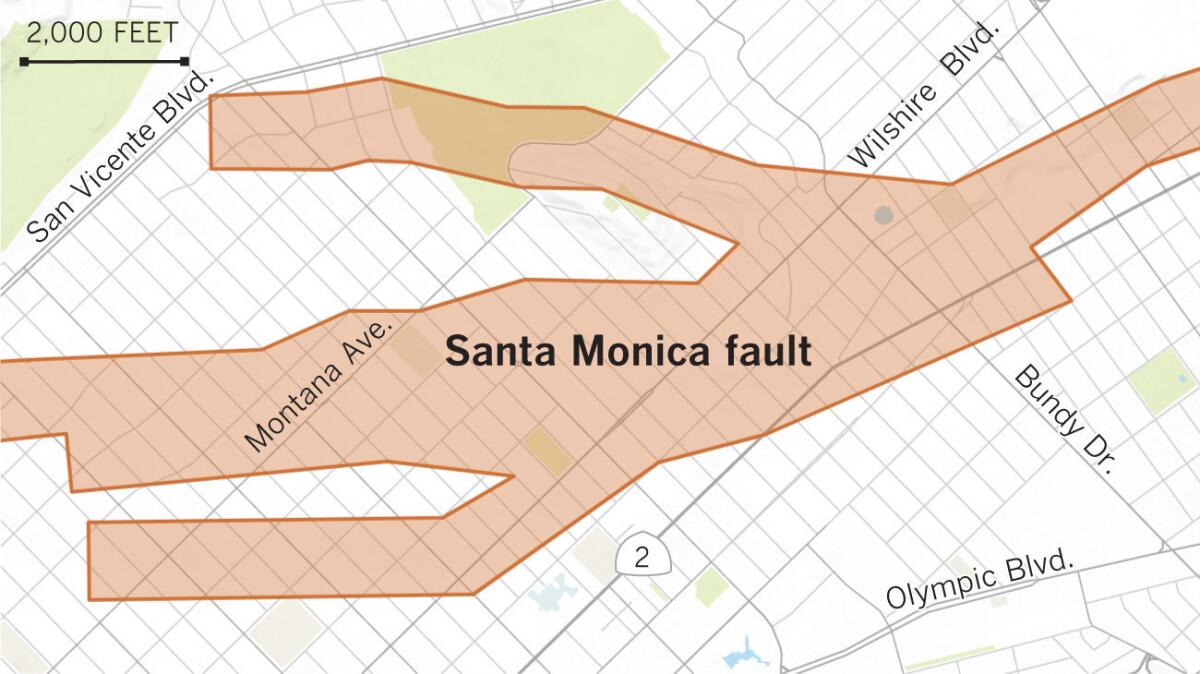
The state’s actions do not affect existing buildings, though structures on and close to faults have a high risk of major damage. The Times found that there are roughly 1,400 buildings on or next to the Santa Monica and Hollywood faults, based on maps available in 2013.
The increased state mapping of faults comes as local governments are trying to improve seismic safety measures. Three cities along the Santa Monica and Hollywood faults, Los Angeles, West Hollywood and Santa Monica, have passed laws requiring property owners to retrofit certain types of buildings at high risk of collapse in major earthquakes.
State lawmakers banned new construction directly on top of faults in official earthquake zones after the 1971 Sylmar earthquake, which ripped apart many homes directly on top of the San Fernando fault, as land on one side of the fault slides past the other. In one neighborhood alone, 80% of homes near the fault suffered moderate to significant damage.
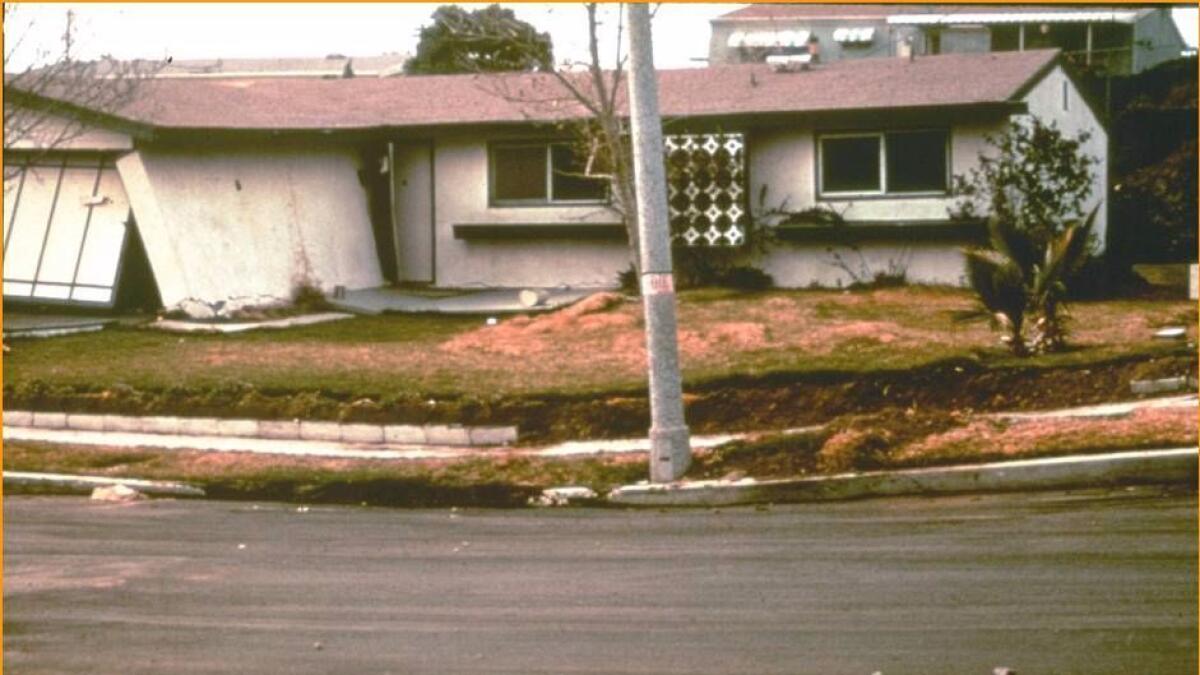
At one home, the earthquake fault’s movement warped the land underneath it. A photo taken by a state official in 1971 showed the fault’s movement dislodging the side wall to a garage and the street bending slightly into the shape of the letter U.
“Prior to the earthquake, the street and lawn was originally flat,” Dawson said.
Once the maps are finalized, state law will require that anyone seeking to build in a fault zone be required to hire a geologist to investigate whether construction will be on an actual fault line. Local building officials will have the final authority to ensure new structures are built away from faults.
“Extra precautions should be taken to ensure new buildings are not located on the trace of an active fault,” Dawson said. “The purpose of the investigation is to identify if there are active faults present, and if there are, then they must be avoided.”
Pacific Palisades, Santa Monica

The Santa Monica fault runs from Beverly Hills and Century City through Westwood and West L.A. along Santa Monica Boulevard. The fault system widens significantly as it moves through Brentwood and Sawtelle toward Santa Monica. One finger moves northwest toward San Vicente Boulevard and another moves south toward Wilshire Boulevard. Eventually, the fault runs through Pacific Palisades.
“Santa Monica Boulevard is there for a reason,” Dawson said — it’s a flat area just below a hillside, a perfect location for the Red Car trolley line that served the area decades ago. The hillside can be dramatically seen at the base of the rolling lawn of the Mormon Temple in West Los Angeles.
Past earthquakes threw up the north side of Santa Monica Boulevard, Dawson said, forming the hillside perch that the Mormon Temple now calls its home and moving it west toward the ocean. The area south of the boulevard is getting relatively lower and has also been shifting to the east.
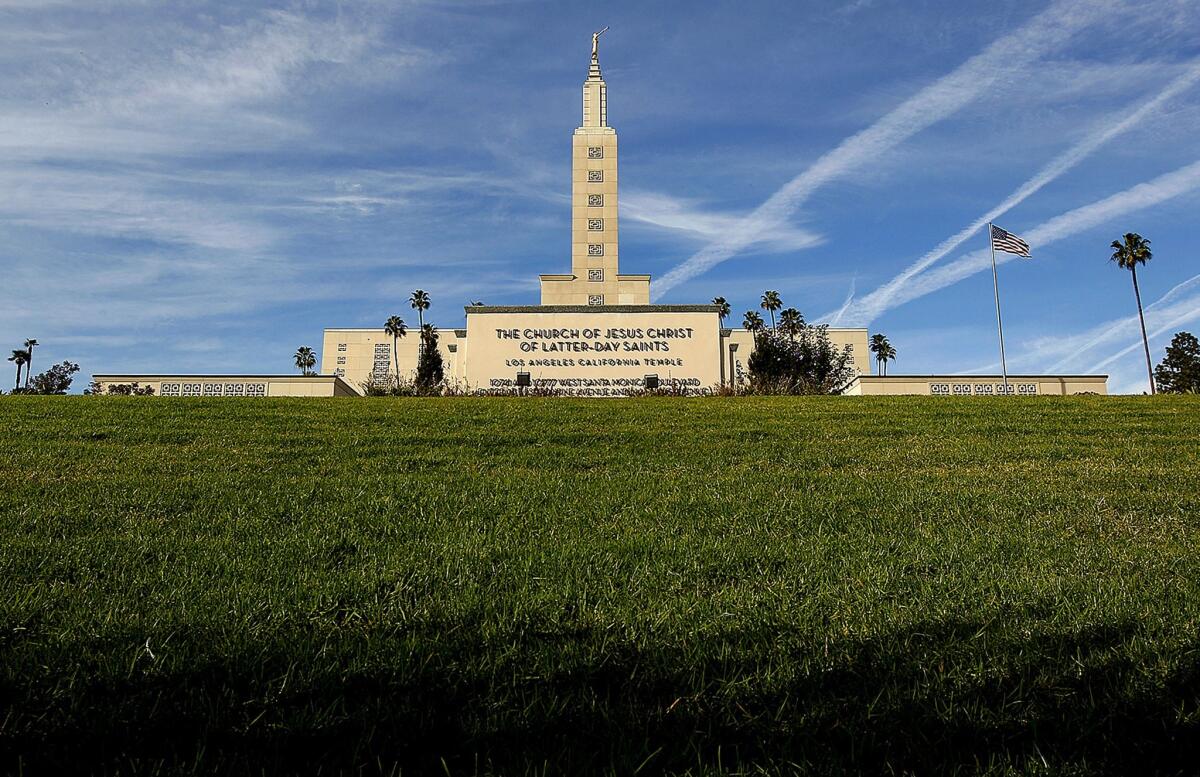
If a couple were holding hands across the Santa Monica fault, a magnitude 7 earthquake could cause the couple to be suddenly separated by 6 to 7 feet.
“The L.A. Basin travels north. The Santa Monica Mountains are going up,” Dawson said. “Everything in L.A. is being squeezed up against those mountains.”
The Santa Monica and Hollywood faults are considered slower-moving faults compared to California’s most famous fault, the San Andreas. While the southern San Andreas produces a major earthquake every 100 to 200 years on average, the Santa Monica and Hollywood are believed to produce major earthquakes every few thousand years on average.
West Hollywood, Beverly Hills
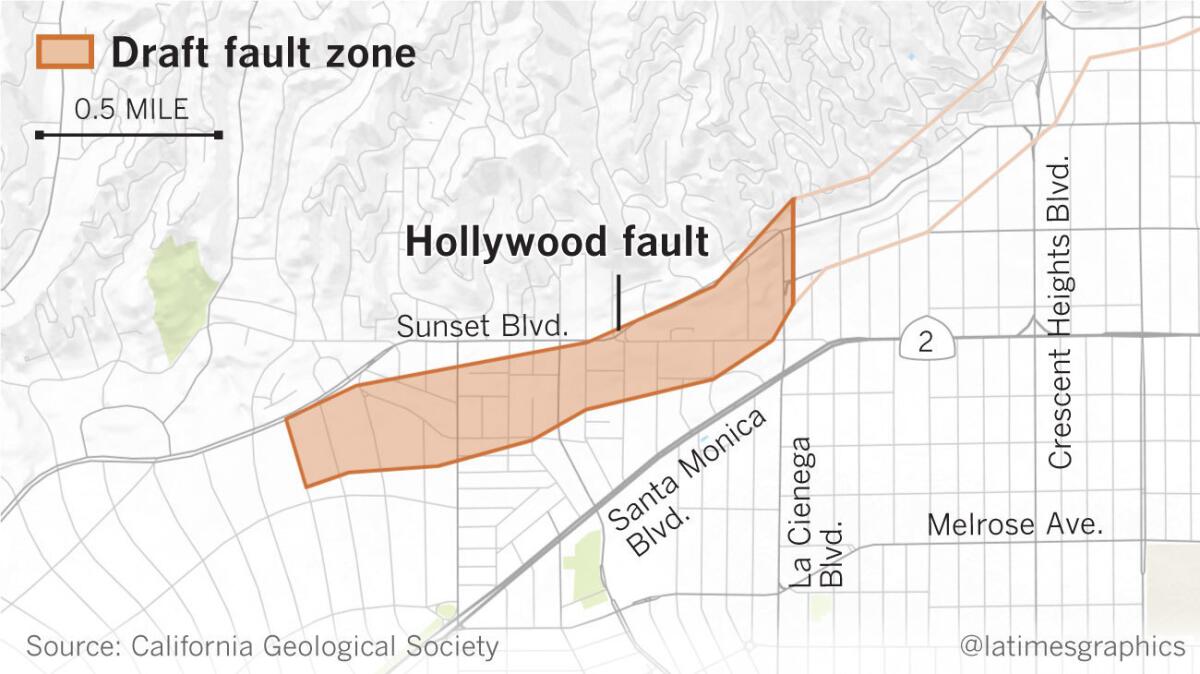
The Santa Monica fault is believed to have last produced a major earthquake about 1,000 to 3,000 years ago. It’s believed to rupture every 7,000 to 8,000 years on average, but it’s possible the earthquake could arrive much sooner than the average. An earthquake on a neighboring fault could, for instance, awaken the Santa Monica fault at any time.
The Hollywood fault is believed to have last shaken in a major earthquake 7,000 to 9,000 years ago, Dawson said. The Newport-Inglewood fault last ruptured in 1933, producing a magnitude 6.4 earthquake that killed more than 100 people.
Pico-Robertson, Mid-City, Culver City
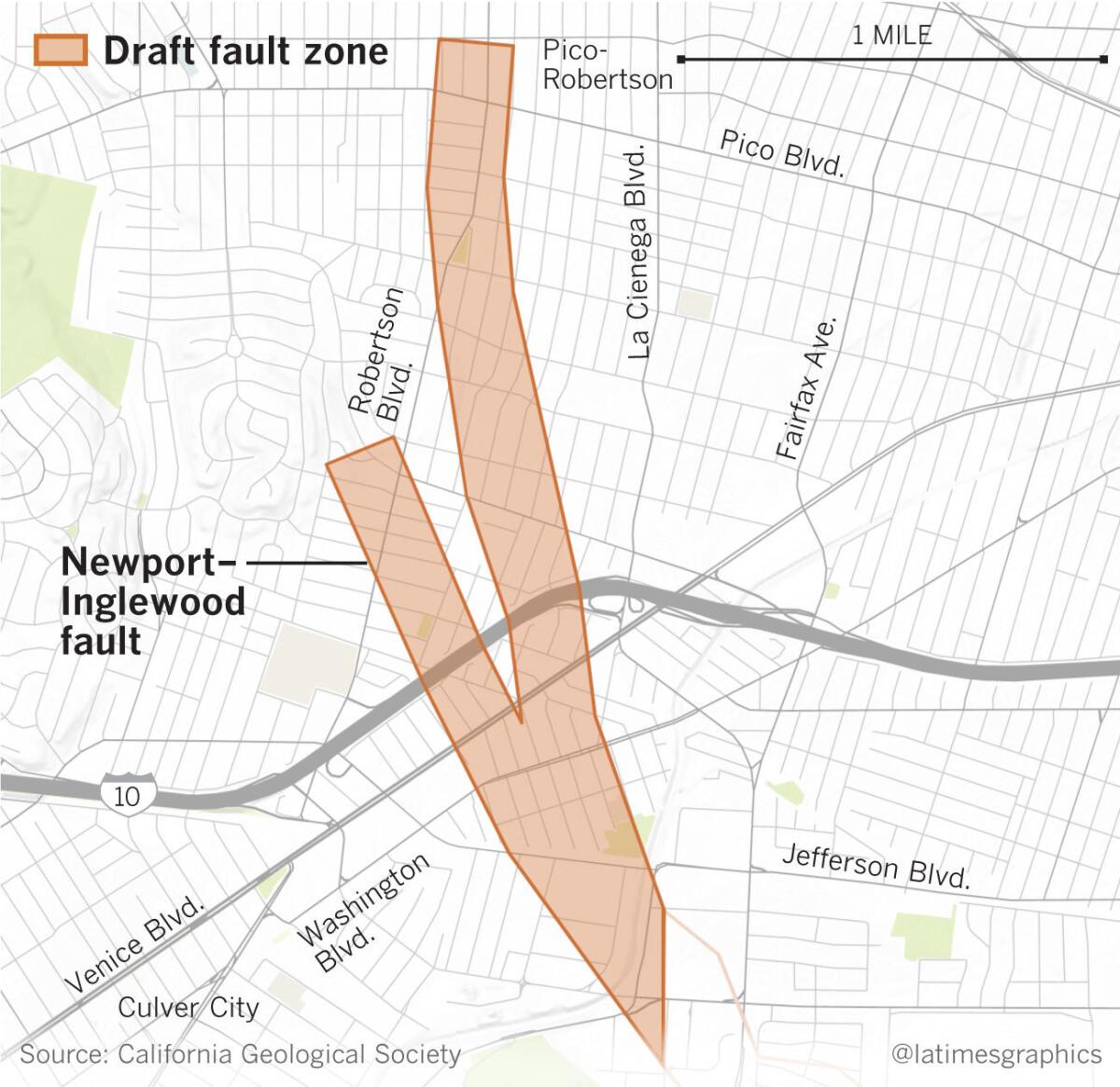
The maps are subject to revisions as the California Geological Survey seeks public feedback. Comments are due to the State Mining and Geology Board by Oct. 11.
State officials also released updated fault maps for areas struck by the magnitude 6 Napa earthquake in 2014. That earthquake revealed previously undiscovered faults that ran through residential homes, destroying the foundations of some of them.
Draft Napa and L.A. earthquake fault maps from the California Geological Survey »
The pace of earthquake map drawing accelerated after Gov. Jerry Brown in 2014 proposed an increase in the state budget to map earthquake faults in California.
In well-established earthquake fault zones, some developers have learned to co-exist with restrictions on development. In one area of Signal Hill, developers carefully built homes around the Newport-Inglewood fault, with parks and trails buffering areas where the ground could split in two.
But the discovery of fissures has led to demolition elsewhere. Los Angeles Southwest College demolished two buildings in 1991 that straddled the Newport-Inglewood fault. The Los Angeles Unified School District tore down a portion of the new Belmont Learning Center after finding that a fault ran underneath it. And San Bernardino Valley College demolished seven buildings along the San Jacinto fault in the 2000s.
In Hayward, the original City Hall sits on the Hayward fault and has slowly been damaged by earth movement. The city abandoned the building after the 1989 Loma Prieta earthquake.
Times staff writer Roger Vincent contributed to this report.
ron.lin@latimes.com | Twitter: @ronlin
raoul.ranoa@latimes.com | Twitter: @ranoa
ALSO
House panel backs earthquake early warning system, defying Trump's plan to kill it
Californians need to be so afraid of a huge earthquake that they take action, scientists say
UPDATES:
5:25 p.m.: Updated throughout, with added details on the science behind the Santa Monica, Hollywood and Newport-Inglewood faults.
2:45 p.m.: This article was updated with a quote from Tim Dawson of the California Geological Survey.
This article was originally published at 1:10 p.m.
Start your day right
Sign up for Essential California for news, features and recommendations from the L.A. Times and beyond in your inbox six days a week.
You may occasionally receive promotional content from the Los Angeles Times.





